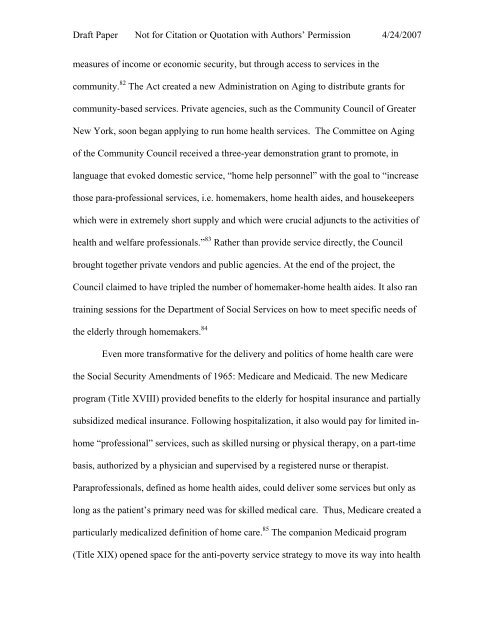Organizing Home Care: - School of Social Service Administration
Organizing Home Care: - School of Social Service Administration
Organizing Home Care: - School of Social Service Administration
You also want an ePaper? Increase the reach of your titles
YUMPU automatically turns print PDFs into web optimized ePapers that Google loves.
Draft Paper Not for Citation or Quotation with Authors’ Permission 4/24/2007<br />
measures <strong>of</strong> income or economic security, but through access to services in the<br />
community. 82 The Act created a new <strong>Administration</strong> on Aging to distribute grants for<br />
community-based services. Private agencies, such as the Community Council <strong>of</strong> Greater<br />
New York, soon began applying to run home health services. The Committee on Aging<br />
<strong>of</strong> the Community Council received a three-year demonstration grant to promote, in<br />
language that evoked domestic service, “home help personnel” with the goal to “increase<br />
those para-pr<strong>of</strong>essional services, i.e. homemakers, home health aides, and housekeepers<br />
which were in extremely short supply and which were crucial adjuncts to the activities <strong>of</strong><br />
health and welfare pr<strong>of</strong>essionals.” 83 Rather than provide service directly, the Council<br />
brought together private vendors and public agencies. At the end <strong>of</strong> the project, the<br />
Council claimed to have tripled the number <strong>of</strong> homemaker-home health aides. It also ran<br />
training sessions for the Department <strong>of</strong> <strong>Social</strong> <strong>Service</strong>s on how to meet specific needs <strong>of</strong><br />
the elderly through homemakers. 84<br />
Even more transformative for the delivery and politics <strong>of</strong> home health care were<br />
the <strong>Social</strong> Security Amendments <strong>of</strong> 1965: Medicare and Medicaid. The new Medicare<br />
program (Title XVIII) provided benefits to the elderly for hospital insurance and partially<br />
subsidized medical insurance. Following hospitalization, it also would pay for limited inhome<br />
“pr<strong>of</strong>essional” services, such as skilled nursing or physical therapy, on a part-time<br />
basis, authorized by a physician and supervised by a registered nurse or therapist.<br />
Parapr<strong>of</strong>essionals, defined as home health aides, could deliver some services but only as<br />
long as the patient’s primary need was for skilled medical care. Thus, Medicare created a<br />
particularly medicalized definition <strong>of</strong> home care. 85 The companion Medicaid program<br />
(Title XIX) opened space for the anti-poverty service strategy to move its way into health
















